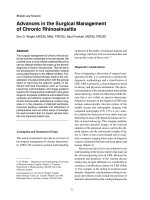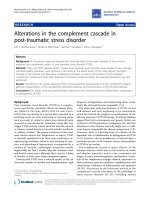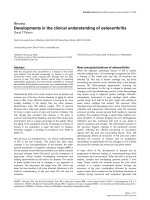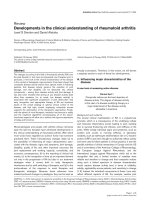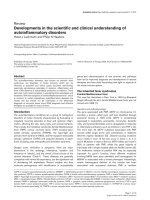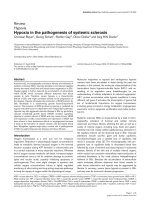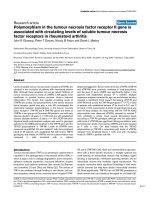Báo cáo y học: "Gout in the spotlight" ppsx
Bạn đang xem bản rút gọn của tài liệu. Xem và tải ngay bản đầy đủ của tài liệu tại đây (38.58 KB, 2 trang )
Page 1 of 2
(page number not for citation purposes)
Available online />Abstract
Understanding how uric acid crystals provoke inflammation is
crucial to improving our management of acute gout. It is well
known that urate crystals stimulate monocytes and macrophages
to elaborate inflammatory cytokines, but the tissue response of the
synovium is less well understood. Microarray analysis of mRNA
expression by these lining cells may help to delineate the genes
that are modulated. Employing a murine air-pouch model, a number
of genes expressed by innate immune cells were found to be
rapidly upregulated by monosodium urate crystals. These findings
provide new research avenues to investigate the physiopathology
of gouty inflammation, and may eventually lead to new therapeutic
targets in acute gout.
In this issue of Arthritis Research & Therapy, Pessler and
colleagues [1] report on mRNA microarray analyses on the
equivalent of the synovial lining cells after monosodium urate
(MSU) crystals were injected into a murine air-pouch; their
study addresses the early phase (9 hours) of the tissue
response to gouty inflammation.
Research on gout and how MSU crystals induce inflammation
has recently taken a step forward, emerging from the
comparative shadows of rheumatoid arthritis research into
the spotlight. In particular, two key publications have challen-
ged our previous ideas about the role of MSU in inflammation.
Rock and colleagues [2] showed that urate crystals behaved
like an adjuvant, stimulating the immune system’s response to
dying cells, and more recently, Tschopp and colleagues [3]
showed that MSU crystals interact directly with the inflam-
masome, a multicomponent cytoplasmic complex that activates
IL-1β. These two reports show that MSU crystals have potent
phlogistic properties and outline some of the mechanisms.
However, there is still a lot to learn about how MSU crystals
trigger an acute attack of gout. The precise mechanisms of
how MSU crystals gain entry into the leukocyte and how
leukocytes then respond to these crystals still need to be
elucidated. There are at least two phases of the early acute
inflammatory response that can be studied, the first being the
effect of MSU crystals on leukocytes and the second the
response of the surrounding tissues. These tissues, which
include vascular endothelium, respond to inflammation to
modulate cell migration, proliferation and metabolic activities
that may all contribute to the clinical physiopathology of acute
gouty arthritis.
The murine air-pouch model utilised by Pessler and
colleagues [1], together with peritoneal injection of MSU
crystals, are both validated models to study the acute inflam-
matory effects of MSU. The results of their study highlight a
set of acute inflammatory genes that were dramatically
upregulated early on in the lining tissue, in particular a
number of genes known to be expressed by macrophages
(PUMA-g, TREM-1 and Irg-1). As expected, the expression of
pro-inflammatory cytokines (IL-1b, tumour necrosis factor-α,
and IL-6) was increased. In addition, some unexpected genes
were also upregulated, such as Hdc and PROK-2. Hdc
encodes histamine decarboxylase and PROK-2 encodes
prokineticin-2.
Their results raise a number of interesting questions and
suggest possible new directions for research that may
improve our understanding of acute gout. Firstly, based on
their findings, it would appear that the main early cellular
response within the pouch lining, and by inference the
synovial lining, is from cells of the macrophage lineage or type
A cells. Are these cells recruited there? Are they present and
ready to respond in situ or do they need priming? The
demonstration that Hdc is upregulated, both in the membrane
and in MSU-stimulated macrophages in vitro, suggests that
histamine is also a key player, though the source is probably
not mast cells but the macrophage. Whether these genes are
relevant in gouty inflammation can now be investigated, as
knockouts for some of these genes are available and
pharmaceutical inhibition is possible for some of the up-
Editorial
Gout in the spotlight
Alexander So
Service of Rheumatology, Centre Hospitalier Universitaire Vaudois, 1011 Lausanne, Switzerland
Corresponding author: Alexander So,
Published: 6 June 2008 Arthritis Research & Therapy 2008, 10:112 (doi:10.1186/ar2396)
This article is online at />© 2008 BioMed Central Ltd
See related research article by Pessler et al., />IL = interleukin; MSU = monosodium urate.
Page 2 of 2
(page number not for citation purposes)
Arthritis Research & Therapy Vol 10 No 3 So
regulated molecules. A major question, in light of the findings
reported by Martinon and colleagues [3], is whether these
events take place downstream of the MSU-inflammasome
interaction or whether they take place concurrently. This too
can be addressed experimentally as the tools are currently
available.
The current data show how genomic analysis can reveal new
insights into a common clinical problem. As clinicians are all
too aware, NSAIDs (non-steroidal anti-inflammatory drugs)
and colchicine are not always without their drawbacks in
clinical practice, particularly in the elderly population with
multiple co-morbidities. Any new therapies that target the
new inflammatory processes set off by MSU crystals will
potentially have a major impact and this will come about only
with a clearer understanding of the underlying mechanisms.
Competing interests
The author declares that they have no competing interests.
References
1. Pessler F, Mayer C, Jung SM, Behrens E, Dai L, Menetski JP,
Schumacher HR: Identification of novel monosodium urate
crystal-regulated mRNAs by transcript profiling of dissected
murine air pouch membranes. Arthritis Res Ther 2008, 10:R64.
2. Shi Y, Evans JE, Rock KL: Molecular identification of a danger
signal that alerts the immune system to dying cells. Nature
2003, 425:516-521.
3. Martinon F, Petrilli V, Mayor A, Tardivel A, Tschopp J: Gout-asso-
ciated uric acid crystals activate the NALP3 inflammasome.
Nature 2006, 440:237-241.


